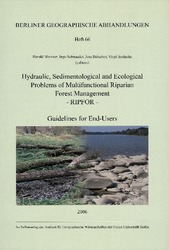Hydraulic, sedimentological and ecological problems of multifunctional riparian forest management - RIPFOR -
guidelines for end-users ; 32 Tabellen
2006Selbstverl. des Inst. für Phys. Geographie der Freien Univ. Berlin, Berlin
Sammelband, digitalisiert
Englisch
Weitere Online-Version: http://resolver.sub.uni-goettingen.de/purl?PPN1020617845
Meixner, Harald; Schnauder, Ingo; Bölscher, Jens; Iordache, Virgil (Ed.), 2006: Hydraulic, sedimentological and ecological problems of multifunctional riparian forest management - RIPFOR - - guidelines for end-users ; 32 Tabellen. Berliner geographische Abhandlungen, 66, Selbstverl. des Inst. für Phys. Geographie der Freien Univ. Berlin, Berlin, DOI: 10.23689/fidgeo-2957.
 |
Dokument öffnen: |
PREFACE:
The problem of prevention with regard to floodplains is related to two extremes:
Prevention of floods and prevention of droughts, both urgent socioeconomic issues
during the last years.
„Retard the flow of water in the stream corridor“ is the message to cope with both kind
of problems. An amphibian landscape will help to maintain water supply during periods
of droughts and by its retention area to reduce peaks of high floods.
Flood retention areas will function sustainably only if there is an intact ecological
system and equilibrium between erosion and accumulation of sediments which in turn
both depend from the evolution of the hydraulic conditions and from the succession of
the riparian forest.
The RipFor — project laid emphasis on the hydraulic processes and their erosion /
accumulation effects in retention areas with the aim to get insight into the interaction
between riparian vegetation, sediment transport, hydraulics and ecology.
Interdisciplinary and intereurOpean work was carried out in the field, the laboratory and
by modelling.
Results of the RipFor — project as presented in the scientific report and the attached
„guidelines for End-Users “ in this way are a contribution to the international discussion
on river restoration and to the implementation of the European Water Framework
Directives.
The scientific report was compiled by Ingo Schnauder and Jens Bölscher (Karlsruhe and
Berlin) from contributions of all partners, whereas the bulk of work on the „Guidelines“
was done by Ingo Schnauder (Karlsruhe), Jens Bölscher (Berlin) and Harald Meixner
(Vienna), who also cared for the layout. Reporting of the Romanian NAS partner was
directed by Virgil Iordache.
Assistance of subcontractors and endusers is highly appreciated, especially by Othmar
Huppmann (Regierungspräsidium Freiburg / former Gewässerdirektion Oberrhein).
Funding within „Quality of Live and Management of Living Resources“ in the RP5
framework of the European Union was essential for this project and is highly
acknowledged.
Prof. Dr. Peter-Jürgen Ergenzinger
Statistik:
ZugriffsstatistikSammlung:
Schlagworte:
LitoralHydrologie
Sedimentologie
Ökologie
Uferpflanzen
land-us
forest management
ecology
 CC BY 4.0
CC BY 4.0

